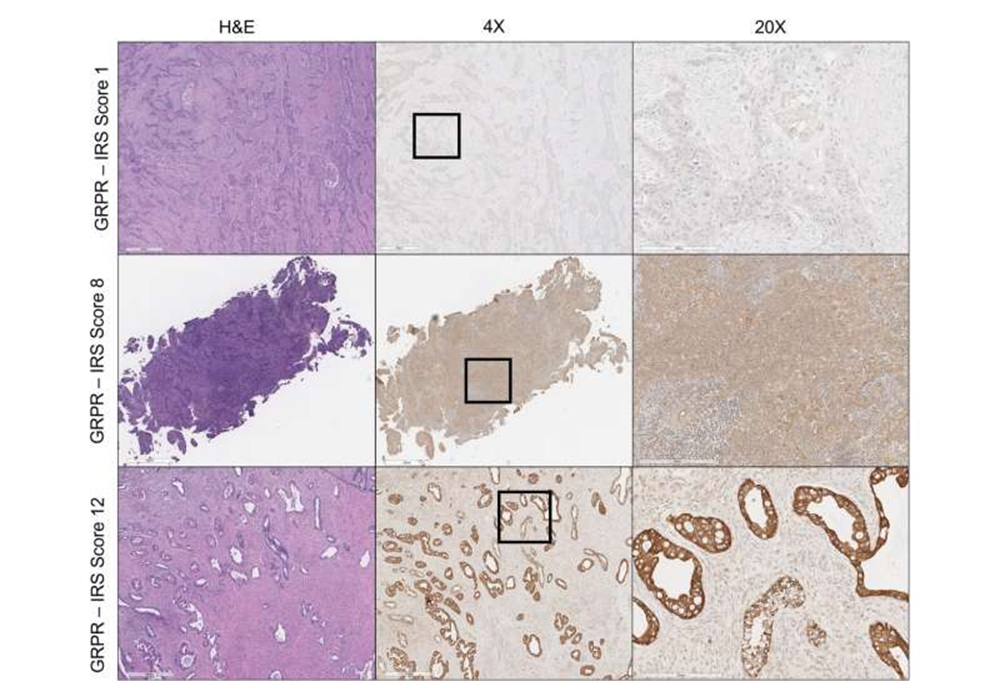
Gastrin- releasing peptide receptor (GRPR) immunoreactivity in uterine cervix cancer. Hematoxylin and eosin (H&E) staining of uterine cervix cancer at ×4 magnification appears in the left column. GRPR staining of uterine cervix cancer at ×4 magnification is in the center, with regions of further magnification boxed. GRPR staining of uterine cervix cancer at ×20 magnification appears in the right column. IRS score is indicated for each row (e.g., percentage of positive cells [4] × intensity of staining [3] = 12: strongly positive). Credit: Frontiers in Oncology (2023). DOI: 10.3389/fonc.2023.1126426
A recent University of Kentucky Markey Cancer Center study suggests a new radiopharmaceutical compound may be a viable treatment option for patients with advanced cervical cancer.
The study, led by UK Markey Cancer Center radiation oncologist Charles Kunos, M.D., and published in Frontiers in Oncology, validates that the radioactive drug 212Pb-DOTAM-GRPR1 may be useful in the treatment of persistent, recurrent, or metastatic cervical cancer.
Radiopharmaceuticals are expected to play an increasingly important role in the future of cancer treatment. They deliver radiation therapy directly to cancer cells, reducing the risk of damage to healthy tissue and resulting in improved treatment outcomes and reduced side effects compared to typical radiation therapy.
"As researchers develop new radiopharmaceutical agents, part of the clinical validation of these efforts is to provide proof that the targets are present in the cancer cells," said Kunos, a professor of radiation medicine in the U.K. College of Medicine. "This study ensures that clinical trials using this agent have the best chance to be successful, which will ultimately bring these advanced therapies to the greater oncology market."
Radiopharmaceuticals require a molecular target to deliver therapy to tumors. 212Pb-DOTAM-GRPR1 targets gastrin-releasing peptide receptor (GRPR), a protein expressed by cancer cells.
Kunos' team evaluated tissue from 33 tumors from women who had metastatic cervical cancer. Most of the tissue studied overexpressed the GRPR, suggesting 212Pb-DOTAM-GRPR1 is a promising therapy to treat the disease.
"As Kentucky has the highest incidence and mortality rate of cervical cancer in the U.S., U.K. has a vested interest in finding new therapies for the disease," said Kunos. "Many of our patients are often presented with a much later stage disease and have the greatest need for a new targeted therapy like a radiopharmaceutical."
The results also validate a phase 1 clinical trial of 212Pb-DOTAM-GRPR1 that is already underway at Markey.
The study is also helping to make the next generation of cancer treatment available to Kentuckians who need it most. Markey is currently only one of only two specialized cancer centers in the U.S. to offer this agent in a clinical trial, and one of a few centers that can offer radiopharmaceuticals.
More information: Charles A. Kunos et al, Human gastrin- releasing peptide receptor expression in women with uterine cervix cancer, Frontiers in Oncology (2023). DOI: 10.3389/fonc.2023.1126426